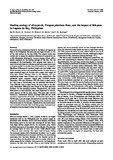Feeding ecology of silverperch, Terapon plumbeus Kner, and the impact fish-pens in Laguna de Bay, Philippines
Share
Abstract
Aquaculture is an important factor in the fishery of Laguna de Bay in the Philippines; fish-pens and net-cages covered ≈10% of the lake surface in the late 1990s. The present study was carried out to assess the possible influences of aquaculture on a wild fish species, silverperch, Terapon plumbeus Kner, with a special emphasis on the feeding ecology of this fish. For the purposes of the investigation, 24-h samples were taken at 2-month intervals close to a fish-pen as well as in open water over a one-year period to acquire more information on this species. Significant differences in standard length and total weight were found between stations and sampling months. In open water, a mean standard length of 53.6 mm and a mean total weight of 4.2 g were found, whereas close to the fish-pen, the corresponding values were 57.6 mm and 5.4 g, respectively. The maximum mean standard length was attained around December 1996 and February 1997 (59.5 mm in open water; 66.1 mm close to the fish-pen), and the minimum was found in June 1996 (49.1 mm in open water; 46.2 mm close to the fish-pen). Noticeable differences were found in the food spectrum between the two sampling stations. Zooplankton, the major food source at both stations, was more important in the stomach content of fish in open water. The same was true for insects (i.e. chironomid larvae), although these did not make up such a large fraction of the diet. On the other hand, close to the fish-pen, aufwuchs-algae, phytoplankton and fish were more important. Generally, benthic organisms were consumed more frequently close to the fish-pen. Zooplankton was more important in the diet of smaller fish. In all size groups, the importance of zooplankton decreased during the rainy season.
Suggested Citation
Kock, M., Focken, U., Richter, H., Becker, K., & Santiago, C. B. (2000). Feeding ecology of silverperch, Terapon plumbeus Kner, and the impact fish-pens in Laguna de Bay, Philippines. Journal of Applied Ichthyology , 16(6), 240-246. https://doi.org/10.1046/j.1439-0426.2000.00240.x
Subject
Taxonomic term
Collections
- AQD Journal Articles [1249]

